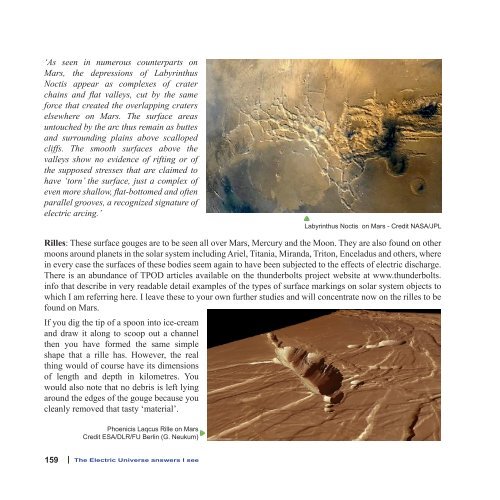A Beginner's View of Our Electric Universe - New
A Beginner's View of Our Electric Universe - New
A Beginner's View of Our Electric Universe - New
Create successful ePaper yourself
Turn your PDF publications into a flip-book with our unique Google optimized e-Paper software.
‘As seen in numerous counterparts on<br />
Mars, the depressions <strong>of</strong> Labyrinthus<br />
Noctis appear as complexes <strong>of</strong> crater<br />
chains and flat valleys, cut by the same<br />
force that created the overlapping craters<br />
elsewhere on Mars. The surface areas<br />
untouched by the arc thus remain as buttes<br />
and surrounding plains above scalloped<br />
cliffs. The smooth surfaces above the<br />
valleys show no evidence <strong>of</strong> rifting or <strong>of</strong><br />
the supposed stresses that are claimed to<br />
have ‘torn’ the surface, just a complex <strong>of</strong><br />
even more shallow, flat-bottomed and <strong>of</strong>ten<br />
parallel grooves, a recognized signature <strong>of</strong><br />
electric arcing.’<br />
Rilles: These surface gouges are to be seen all over Mars, Mercury and the Moon. They are also found on other<br />
moons around planets in the solar system including Ariel, Titania, Miranda, Triton, Enceladus and others, where<br />
in every case the surfaces <strong>of</strong> these bodies seem again to have been subjected to the effects <strong>of</strong> electric discharge.<br />
There is an abundance <strong>of</strong> TPOD articles available on the thunderbolts project website at www.thunderbolts.<br />
info that describe in very readable detail examples <strong>of</strong> the types <strong>of</strong> surface markings on solar system objects to<br />
which I am referring here. I leave these to your own further studies and will concentrate now on the rilles to be<br />
found on Mars.<br />
If you dig the tip <strong>of</strong> a spoon into ice-cream<br />
and draw it along to scoop out a channel<br />
then you have formed the same simple<br />
shape that a rille has. However, the real<br />
thing would <strong>of</strong> course have its dimensions<br />
<strong>of</strong> length and depth in kilometres. You<br />
would also note that no debris is left lying<br />
around the edges <strong>of</strong> the gouge because you<br />
cleanly removed that tasty ‘material’.<br />
Phoenicis Laqcus Rille on Mars<br />
Credit ESA/DLR/FU Berlin (G. Neukum)<br />
15 | The <strong>Electric</strong> <strong>Universe</strong> answers I see<br />
Labyrinthus Noctis on Mars - Credit NASA/JPL


